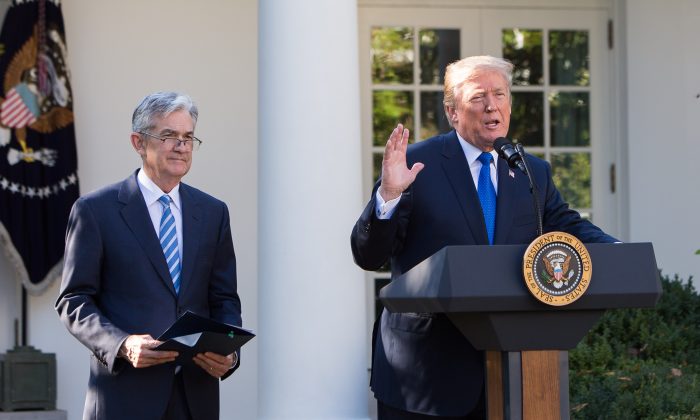President Donald Trump fired the latest salvo on Dec. 17 in his campaign to pressure Federal Reserve chairman Jerome Powell to hold interest rates steady.
The president cited the strong U.S. dollar, steady inflation rate, and slowing growth in China as key factors the central bank considers in determining the course of national monetary policy.
“It is incredible that with a very strong dollar and virtually no inflation, the outside world blowing up around us, Paris is burning and China way down, the Fed is even considering yet another interest rate hike. Take the victory!” Trump said.
After maintaining interest rates at a historic low throughout the Obama administration, the Fed increased the base interest rate eight times since late 2016 from virtually zero to 2.25 percent. The Fed intends to continue raising rates until 2020. Similar cycles of rate increases previously resulted in stock market crashes or economic recessions.
The president began criticizing Powell, his appointee, in July this year after three quarter-point rate rises in a row.
“China, the European Union and others have been manipulating their currencies and interest rates lower, while the United States is raising rates while the dollars gets stronger and stronger with each passing day—taking away our big competitive edge,” Trump said in a Twitter post on July 20.
“The United States should not be penalized because we are doing so well,” Trump added. “Tightening now hurts all that we have done. The United States should be allowed to recapture what was lost due to illegal currency manipulation and bad trade deals. Debt [is] coming due and we are raising rates—really?”
The president’s referred to tightening points to another change of course the Fed embarked on towards the end of the Obama administration’s term. Instead of buying up assets under the quantitative easing strategy, which added liquidity to the market place, the Fed began selling assets—or quantitative tightening.
Impacts of the tightening cycle were temporarily offset by central banks around the world were still following an easing cycle, but the global course reversed on Oct. 1, according to Stanley Druckenmiller, a former investor and hedge fund manager.
“This is a time for choosing. We believe the U.S. economy can sustain strong performance next year, but it can ill afford a major policy error, either from the Fed or the rest of the administration,” Druckenmiller said in a Dec. 17 op-ed published by The Wall Street Journal. “Given recent economic and market developments, the Fed should cease—for now—its double-barreled blitz of higher interest rates and tighter liquidity.”
Congress mandates the Fed, a private entity, with steering U.S. monetary policy to pursue full employment and stable prices. Some economic indicators—including U.S. economic growth and employment—are healthy and tilt the scales towards a rate increase. Meanwhile, other key measures, like a steady inflation, a declining stock market, and slowing global trade growth, point toward holding back a rate hike.
Trump’s rhetoric has grown increasingly sharp since July. In Oct., the president told Fox Business Network the central bank is his biggest threat. In Nov., he told The Washington Post the Fed is a bigger problem than China.
From The Epoch Times


